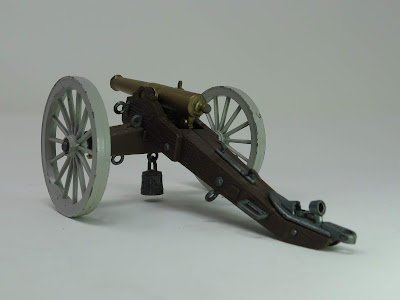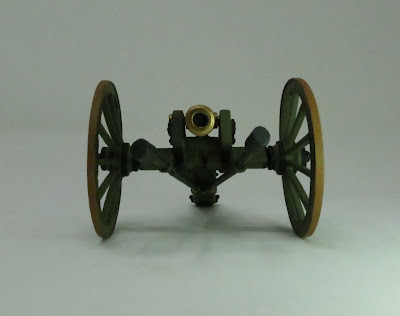Family tree
W. Britain has been making and marketing American Civil War cannons since 1951. Over the last dozen years I have acquired the progression of the Britain's 12-pounder light gun howitzer - "Napoleon"- in its various incarnations over nearly seven decades.
I have always been a fan of Civil War artillery, especially the Napoleon, and in my role as a ranger for the National Park Service I have often been in very close proximity to that gun, and have become fairly intimate with it's design and operation.
The firing of the 12-pounder light-gun howitzer (Napoleon) at Artillery Weekend at Antietam National Battlefield.
So onward then, through the years with walk-arounds of four incarnations of this magnificent gun.
W. Britain #2057, 2058, 1951
This gun was originally introduced in the 1930s as a British fieldpiece but it was reintroduced in 1951 (a year before my birth) as numbers 2057 and 2098. The accounting for the two numbers is that it came in two versions, one with a Confederate crew and the other Union.
Although not expressly a Napoleon, and quite generic actually, nonetheless for the purposes of this family tree I am including it.
It is a very handsome gun though its similarity to an actual ACW gun is a little questionable in some respects.
For one thing the barrel is overly long for a Napoleon and rather diminutive in girth.
Another divergence for the actual American gun is the very wide, stout trail...
as well as the prominent rivets along its length.
It has a simple spring-loaded firing mechanism, with a robust threaded-post and wheel, in brass, to elevate or depress the angle of fire.
The size of the elevating wheel rather overwhelms the lines of the gun, and puts me in the mind of a desk cigarette lighter. Care for a smoke?
Altogether an nice gun, but it bears only a passing resemblance to the Napoleon...any old port in a storm for a kid playing Civil War in the late fifties and early sixties I guess. In fact this may have been the go-to gun for the bedroom floor battles of the 1961-65 Civil War centennial era.
W. Britain "Deetail" 7464, 1966
And speaking of the centennial... W. Britain was, unfortunately, a day late and a dollar short for that national observance; not issuing it's Deetail (or Eyes Right, I'm not sure, maybe a reader can leave a comment) Napoleon in 1966.
This impressive model was boxed individually as #8726, or as it's usually seen, as part of set 7564 - the four-horse gun and limber team.
The wheels are slightly oversized and the barrel is equally undersized, but the carriage and many of the details are pretty faithful to and actual 12-pounder.
The stance of this gun is quite out-of-scale...much wider than the actual gun.
Elevation and depression of the barrel is achieved through turning the geared crank, and although I've not fired this one, the upward projecting lever is the spring-loaded firing trigger.
I'm sorry that I didn't have this one as a child, but realistically, it was priced beyond my parent's reach and never appeared under my Christmas tree (must be why I'm over-compensating now!).
W. Britain #17227, 2002
Now we're getting serious!
The Union six-horse limber and gun combination (#17379) came out in 2002 and it was a quantum leap in accuracy and detail. It also marked the transition from "toy" to "miniature" in Britain's artillery.
This is a really beautiful piece in nearly all respects.
Britain's attention to detail included realistically painted the iron tyres of the wheels a nice rusty color, denoting field use.
The gun tube is quite superb and really captures the true dimensions and color of the bronze barrel - which was always burnished bright by Civil War batterymen.
My complaints are very few about this gun. One is the overly robust trail. The actual trail on a 12-pounder is not this wide.
Similarly, the wood grain detail, though nice, is not representative of the smoothly-planed white oak that comprised an actual trail .
On this version the tube is slightly depressed as it comes towed behind the limber when on display.
Unlike its progenitors, this gun has the rope prolonge in place.
It also has a detailed elevation screw and two sponge rammers, though one should actually be replaced by the corkscrew-like "worm".
In all respects, a really beautiful gun; and though no longer marketed as a "toy" it has still seen plenty of action on my toy soldier table and has sent many a plastic soldier to his celestial reward.
W. Britain #31066, 2010
Here then, is the apex...so far.
This is the fourth-generation Britain's Napoleon introduced in 2010, and it's exquisite.
This gun comes with the trail spike (or "hand spike") deployed.
Each gun carried two hand spikes stowed on each cheek of the gun. This long lever provided enough leverage for a single man to deflect the gun to the left or right.
In this rear-view you can just see the second spike on the left cheek of the gun. Also in this view you can see my one criticism of this gun, and that is the width of the trail; unlike its overly-wide predecessor, this trail is now too narrow compared to the real thing.
The elevating screw is wonderfully cast, to the point where it actually looks functional.
The front blade sight is cast to perfect scale.
The tube detail is outstanding with knob, vent, and the bracket from which the pendulum-hausse rear sight was suspended.
The hooks and rings for implement stowage are beautifully cast, as is the water bucket.
The trails tell the tales. This seems to be the universal weakpoint for each of these guns. Either too wide, too narrow, or too short, W. Britain hasn't quite gotten it right. Perhaps in its next reincarnation W. Britain will achieve the perfection that the actual gun deserves.
My affinity for the twelve-pounder began as an eight-year-old enthralled with the Civil War and continues through to what I do for a living today. I'm a lucky guy.
Keep me in your sights until next time.
Soldier on!
Mannie
p.s.
Please do leave comment, and especially corrections.




















































2 comments:
I arrived here via a FB post. Glad I got to read this, quite enjoyable. Thank you, Mannie.
Hi Mannie, i remember the old split breach cannon being available in the early 60's in a boxed set with the new Britains plastic "Herald" range of ACW figures, you got the cannon with four Union or Confederate figures. Previously it was issued with the hollowcast metal ACW range and also with the Waterloo range (they did British line infantry, Highlanders and Royal artillery gunners but no french to oppose them).
The next version with the plastic trail, went with the Herald infantry when it was first issued but then when Britains brought out the better quality swappet "Eyes Right" they also made a limber and then a gun crew in this range to go with it. When the "Eyes Right" range gave way to the "Deetail" range the gun was still available on it's own but the crew was dropped and the limber reissued for a short time with new "Deetail" riders.
Best wishes, Brian
Post a Comment